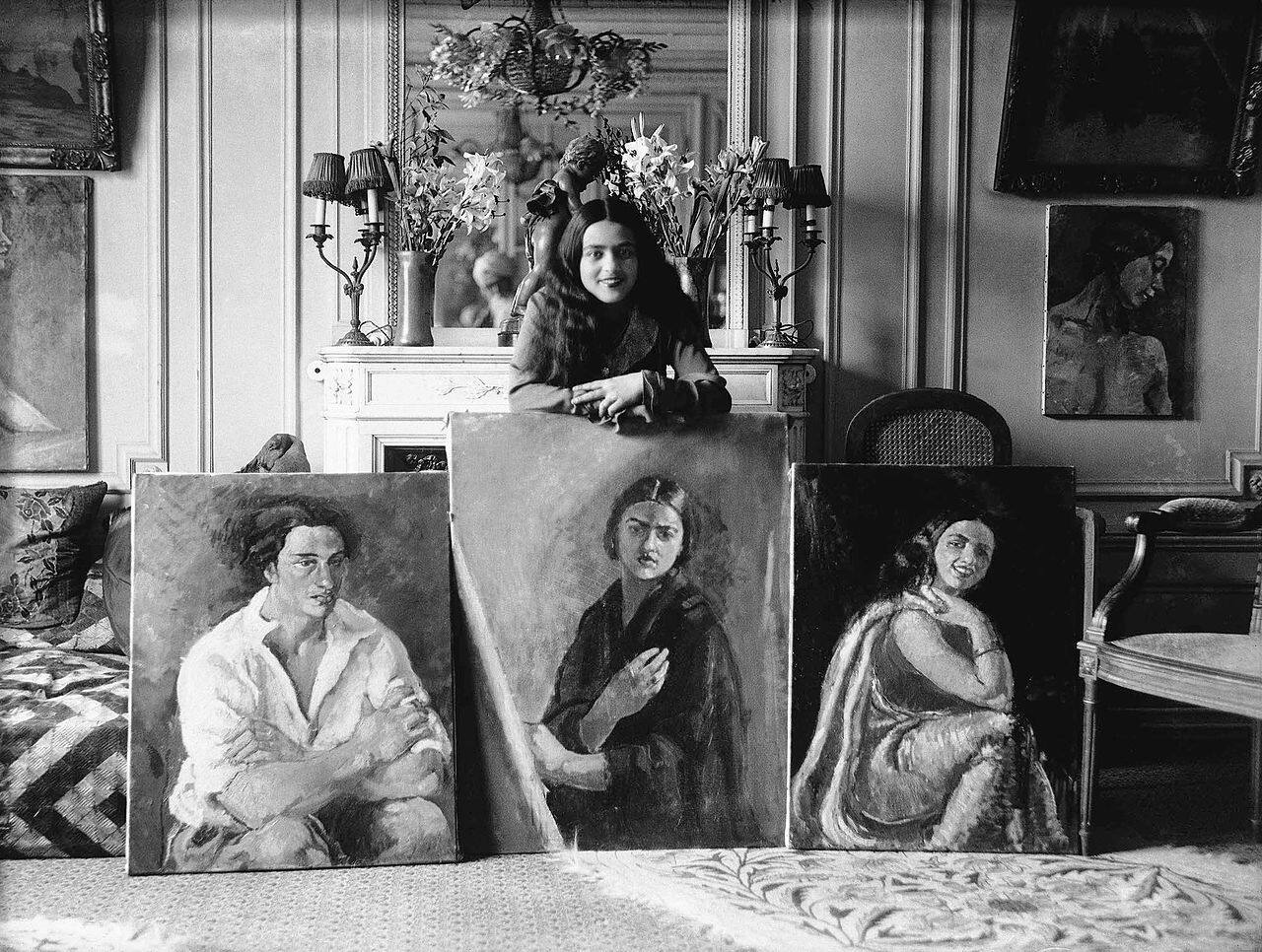



Vivan Sundaram sat in the front row at the Max Mueller Bhavan in New Delhi listening to Okwui Enwezor, the first Black curator of the Venice Biennale, talk about the responsibility of artists in responding to challenges faced by the society. It was a chilly December evening in 2014 and Sundaram had arrived to support the Nigerian-born Enwezor, his longtime friend, who had chosen the theme, All the World's Future, for the Venice Biennale where he would play recordings from the Guru Granth Sahib and Karl Marx's The Capital in the same hall to invoke the close links between politics and society. In many ways, Sundaram, one of the world's finest artists who passed away today at the age of 79, had melded his artistic practice from the beginning towards the diverse ideas of artistic possibilities.
 A Vivan Sundaram installation (Photo courtesy Kiran Nadar Museum of Art)
A Vivan Sundaram installation (Photo courtesy Kiran Nadar Museum of Art)
Sundaram was always engaging with ideas and ideologies, ensuring that his art spoke up louder for a better world. He did that as an artist, art teacher, organiser of cultural events and a member of the audience at talks and shows like Enwezor's. Decades before the founding of the Kochi-Muziris Biennale in Kerala, he had helped organise an edition of the Triennale India, bringing artists from across the country to the national capital. He was one of the founders of the Safdar Hashmi Memorial Trust (SAHMAT), which would respond to social and political causes by inviting diverse artistic practices and voices to the streets of Delhi.
His politics came through in one thoughtfully put-together exhibition after another. Back in the 1970s, his used black oil to make sketches for his series Engine Oil about the Iraq war. The Gagawaka exhibition mixed fashion and fabrics to talk about politics. And Trash explored lost causes and cities using waste material collected from around Delhi. Each show underlined his shifting of mediums as a necessary reaction to explore what is happening within the society. After the 1992 Mumbai riots, he used a photograph of a man lying dead on the roadside for an installation. When Bhupen Khakhar died, his artistic tribute to his friend was titled Bad Drawings for Dost. He spent on the floor of a huge hall at the Aspinwall House venue of the first edition of Kochi-Muziris Biennale for weeks to place the pieces of terracotta tiles he had carefully picked from an excavation site in Pattanam village near Kochi for his Black Gold installation that recreated the ancient city of Muziris lost two millennia ago in a mysterious deluge. His leaning towards photography was influenced by his aunt, the famous painter Amrita Sher-Gil, who was the elder sister of Sundaram's mother Indira Sundaram. He would go on to create collages of Sher-Gil's photographs from their family home in Shimla. He even made a movie on Sher-Gil, and wrote books (Re-take of Amrita, Amrita Sher-Gil: A Self-Portrait in Letters and Writings, the last co-authored with Salman Rushdie).
 Amrita Sher-Gil with 3 paintings (Photo by Umrao Singh Sher-Gil via Wikimedia Commons)
Amrita Sher-Gil with 3 paintings (Photo by Umrao Singh Sher-Gil via Wikimedia Commons)
Born in Shimla, Himachal Pradesh, on May 28, 1943, Sundaram studied painting at the Maharaja Sayajirao University, Baroda, before going to the Slade School of Art in London in 1966 for higher studies. A painter, he swiftly moved to include a wider range of mediums to his vast repertoire. He was a pioneer of installation art in India, using the medium to explore newer creative possibilities and thereby influencing a generation of artists to follow in his footsteps.
For Sundaram's contemporaries, his passing away today marked the end of an era. "It is difficult to say in a few words about a 60-year-old friendship," says artist Ghulam Mohammed Sheikh, a contemporary of Sundaram. "We have been friends from 1961, when he came to study in Baroda, and remains so till now. We have been together in a number of exhibitions and art projects and were comrades-in-arms together in SAHMAT championing the cause of a secular and multicultural India," adds Sheikh.
"From the time I knew him, Vivan was a pathbreaker," says Neelima Sheikh, another contemporary of Sundaram. "He always showed the way as his personality did. He had an amazing quality of initiative. Every time you saw his works there was something new, contributing to the contemporary art scene. He was also brilliant with his administrative abilities," adds Neelima Sheikh.
For many younger artists, Sundaram has been a mentor, critic and friend. Artist Gigi Scaria remembers Sundaram teaching installation to his master's in fine arts (painting) class at the Jamia Millia Islamia, New Delhi. "He joined Jamia Millia Islamia's guest faculty in the same year I started my M.F.A and taught us installation and a general understanding of art. But beyond teaching, he gave us contacts in the art circle in Delhi to help in our practice," says Scaria, a participating artist in the Venice Biennale in 2011. "He was a rare kind of artist. As a teacher he tested us and provoked us to create an intellectual rigour within us. He involved all art students in a project and organised an exhibition of all works at the end of the project," adds Scaria.
Delhi-based artist George Martin considers Sundaram a mentor, critic and friend to many younger Indian artists. "He was the first Indian artist who made installation art mainstream. He also incorporated different collaborative platforms like fabric, photography and video art. He was singularly responsible for bringing scale to contemporary art different from the gallery space. In a way, he made space as art itself," says Martin.
Jorhat-based physical theatre artist Shilpika Bordoloi recalls an occasion when Sundaram lent her costumes for her new stage performance, Majuli, in 2013. Bordoloi, who participated in Sundaram's Gagawaka exhibition in Delhi in 2012, wanted to use a particular costume Sundaram had created for one of his works in the show. "I asked Vivan if I could use the dress made of crepe bandages he had used in the exhibition for my stage performance. He went on to make a new costume for me and couriered it to Assam. He refused to take money from me for it," recalls Bordoloi.
 Shilpika Bordoloi in the garment designed for her by Vivan Sundaram
Shilpika Bordoloi in the garment designed for her by Vivan Sundaram
Gurgaon-based artist Arun Kumar HG says he was inspired by Sundaram to launch an art and activism forum in his village in Shimoga district of Karnataka. "I was a B.F.A (sculpture) student at the MS University, Baroda, when Vivan asked some of the art students to join a Janotsav art exhibition organised by SAHMAT in Mangolpuri, Delhi, in 1991. I was asked to assist artist K.P. Soman, who was making sculptures to be placed in a park adjoining a slum area. It was there that I came to know about Vivan and his activism," says Kumar. "It was a great learning moment about how art and activism go together," adds Kumar, who founded SARA (Sustainable Alternatives for Rural Accord) in Dombekoppa village in Shimoga district in 2014 as a platform for farmers, villagers and students to exchange ideas about sustainable and environmental concerns through art.
Discover the latest Business News, Sensex, and Nifty updates. Obtain Personal Finance insights, tax queries, and expert opinions on Moneycontrol or download the Moneycontrol App to stay updated!